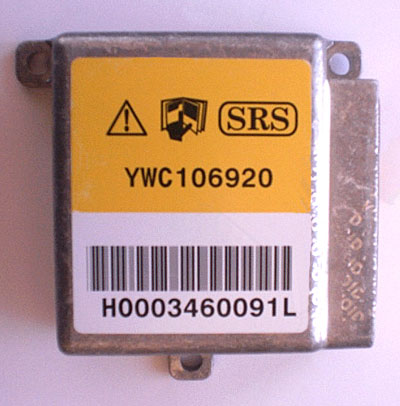 TRW SPS (TYPE 2/P38 NRR) - System Overview
TRW SPS (TYPE 2/P38 NRR) - System Overview TRW SPS (TYPE 2/P38 NRR) - System Overview TRW SPS (TYPE 2/P38 NRR) - System Overview |
| Introduced into the P38 range rover during the 1999 face lift, specifically to support additional safety features of Seat Belt Pretensioners and Side Air Bags mounted in the seats. This means that it is very easy to determine if this ECU is fitted simply by looking for the SRS tag sewn into the side edge of the seat back rest. The ECU will also support additional external Crash sensors which are fitted in the NAS market. |
 SM013 - TRW SPS (TYPE 2/P38 NRR) - System Help file SM013 - TRW SPS (TYPE 2/P38 NRR) - System Help file |
| Version 1.27 |
 TRW SPS (TYPE 2/P38 NRR) - Known Fitments TRW SPS (TYPE 2/P38 NRR) - Known Fitments |
||||||||
Vehicle makes, models and variants known or believed to be using this vehicle system, required diagnostic lead and degree of known compatibility.
|
 TRW SPS (TYPE 2/P38 NRR) - Physical Details TRW SPS (TYPE 2/P38 NRR) - Physical Details |
 |
 TRW SPS (TYPE 2/P38 NRR) - Pin Outs TRW SPS (TYPE 2/P38 NRR) - Pin Outs |
||||||||||||||||||||||||||||||||||||||||||||||||||||||||||||||||||||||||||||||||||||||
Details of the pin usage for the ECU connector(s).
|
 SM013 - TRW SPS (TYPE 2/P38 NRR) - Diagnostic Capabilities (Read Fault Codes) SM013 - TRW SPS (TYPE 2/P38 NRR) - Diagnostic Capabilities (Read Fault Codes) |
| This airbag system can self detect up to 37 faults. Most of these are major or safety related faults causing full system shutdown with only a few being minor caused by, for instance a flat battery. The systems perform a self-diagnostic test that takes about 15 seconds whenever the ignition is switched on, logging any faults that are found, and then at regular intervals thereafter. Resistors are placed at strategic points in the airbag wiring harness / loom giving the systems the ability to self detect open or short circuits. Main loom loops are from the ECU up the column through the spiral cassette through the airbag and back through the spiral cassette to the ECU; from the ECU through the passenger airbag and back again; on MPS systems, one through each of the two crash sensors mounted behind the head lamps at the front and then returning to the ECU, and then two loops each going to the instrument cluster, through a bulb each and back again. In accordance with the manuals no repairs must be carried out on the loom at all, hence no wiring diagram is supplied in the manufacturer's manuals. All problems involving the airbags, spiral cassette, crash sensors, or loom must be done in strict accordance with the relevant manufacturer's workshop manual instructions. There is a deep memory within the airbag ECU that keeps a long-term record of resets to detected faults. This means that if a particular connection was poor and went open circuit - even just once - the fault would be logged by the system as - a sensor is open circuit - and the airbag warning light would come on. If the fault was not found and the fault code memory was cleared it would be very likely to reappear. This would be logged as an intermittent fault within the system. |
 SM013 - TRW SPS (TYPE 2/P38 NRR) - Diagnostic Capabilities (Clear Fault Codes) SM013 - TRW SPS (TYPE 2/P38 NRR) - Diagnostic Capabilities (Clear Fault Codes) |
| This function checks the fault code memory for resident faults and clears the fault code memory if the fault has been rectified. Having deleted the faults the system then rechecks the fault memory to ensure that it is clear. Failure to clear the fault memory successfully is usually due to the system re-logging the fault the moment the fault memory is clear, meaning that the fault has not been rectified properly and as far as the system is concerned, still exists. The system may also carry out a re-check for successful clearing of the fault code memory but then the system may re-log the fault shortly after. |
 SM013 - TRW SPS (TYPE 2/P38 NRR) - Diagnostic Capabilities (Settings) SM013 - TRW SPS (TYPE 2/P38 NRR) - Diagnostic Capabilities (Settings) |
| Values, configuration settings, and other stored information which can be read from the ECU, edited and then rewritten back. Read settings can also be stored as a standard HTML page for reference. These pages can then later be re loaded and re written back to the ECU. Please note that some values may be read only due to the fact that they are supplied from the ECUís ROM or are internally calculated. The SRS airbag has only one programmable option:
|